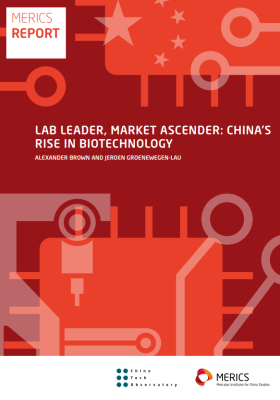

Data policy push + SME financing + Green hydrogen
MERICS Top 5
1. Data policy push: China is set on scaling up its data industry
At a glance: The National Development and Reform Commission (NDRC) and five other departments have issued guiding opinions for the development of China’s data industry. Examples are data collection, data computing and storage, data trading, data security and the construction of data infrastructure. Key aspects include:
- Building a digital economy and accelerating the construction of a digital China
- Achieving an average annual growth rate in the data industry of more than 15 percent by 2029
- Cultivating “a number of” internationally competitive data companies by 2029
- Promoting the circulation and trading of data, for example through data exchanges and third party-platforms
MERICS comment: The guiding opinions show China increasingly views data as a source of growth as well as a means of achieving across-the-board industrial upgrading and modernization. The last few months have witnessed a significant policy push in this field, including opinions on utilizing enterprise data resources, a pilot program for the whole-process management of data assets, opinions on the development of the data-annotation industry and guidelines for the construction of a national data infrastructure.
To realize the potential of data, it must be made accessible to economic actors who can create value from it. China’s government had been promoting data exchanges, digital marketplaces for the trading of data, but these efforts ran into problems over unclear data ownership, data pricing and poor protections for personal information. Beijing responded with reforms to promote legal clarity, tighter government control, more efficient data pricing and greater trust within the market. These seem to have produced some positive results. China’s data transaction market is expected to be worth USD 28.8 billion in 2025, up from USD 12.3 billion in 2022. However, the future success of China’s data exchanges is uncertain due to heavy state-involvement, limited private sector participation and doubtful profitability.
Crucially, by viewing data as a factor of production, Beijing employs it as a supply-side means to achieve productivity gains and boost its manufacturing sector. As a result, European actors may find themselves facing challenges to their competitiveness vis a vis Chinese firms.
Article: Guiding Opinions on Promoting the High-Quality Development of the Data Industry (国家发展改革委等部门关于促进数据产业高质量发展的指导意见) (Link)
Issuing bodies: NDRC, NDA, MOE, MOF, SAFR, CSRC
Date: December 30, 2024
2. China wants better financing for its strategic and high-tech SMEs
At a glance: The Ministry of Industry and Information Technology (MIIT) and four other departments launched their “One Month One Chain” promotion activities for small and medium sized enterprises (SMEs). The program runs from November 2024 till December 2025, with investment and financing activities organized around one industrial chain per month. The aim is to create an effective financing environment to meet the needs of strategic SMEs. This includes providing better access to equity, credit, insurance services, the promotion of mergers and acquisitions (M&As) and other kinds of restructuring to facilitate growth. Target SMEs include:
- High-quality SMEs, which include “Little Giants” and “specialized, new” SMEs
- SMEs at key supply chain nodes, which explicitly need to tackle new technologies, develop new products, and support the industrial chain
- Other key SMEs, such as digital transformation SMEs or SMEs in strategic industry clusters
MERICS comment: This policy builds on Beijing’s longstanding support for strategic SMEs. With initiatives like the “Little Giants” program, China has created an “accelerator state” with a tiered cultivation system that tries to identify and support promising SMEs to become drivers of innovation and leaders in their niche markets.
The focus on SME financing aims to address China’s long-standing, systemic failure to direct adequate funding towards its SMEs. The share of SMEs in total bank loans in China has only risen from 35 percent in 2015 to 41 percent in 2022, despite monetary policy measures and financing quotas designed to direct a larger share of bank financing towards SMEs. Nevertheless, the party-state’s accelerator system had successfully nurtured 114 “Manufacturing Champions” from the first three batches of “Little Giants” selected by 2022.
By increasing financing opportunities, Beijing is signaling its commitment to support strategic SMEs, a move that may be to the detriment of international competitors. The “Little Giants” program targets strategic sectors – where European SMEs often dominate – and the aim is to replace foreign providers, first in China, then in global markets. Better access to financing will enable Chinese firms to scale up domestic production more readily, invest in research and development (R&D) and overseas expansion and become more competitive against EU counterparts. The buildup of SMEs may temporarily increase demand for some critical inputs, such as machinery, but the overall goal is to create Chinese alternatives to European suppliers.
Article: Notice on Carrying out the "One Month One Chain" SME Financing Promotion National Activities (五部门关于开展“一月一链”中小企业融资促进全国行活动的通知) (Link)
Issuing bodies: MIIT, MOF, PBOC, SAFR, CSRC
Date: December 10, 2024
3. China wants to decarbonize its hydrogen industry, relying on state-owned enterprises
At a glance: The MIIT and two other departments released an implementation plan to accelerate the use of green hydrogen in industry. The goal is to achieve the large-scale use of green hydrogen in metallurgy, synthetic ammonia, synthetic methanol and refining, as well as its initial application in sectors, like shipping and aviation, by 2027. Key measures include:
- Strengthening supply-demand coordination, such as between hydrogen suppliers and industrial enterprises in energy-rich regions
- Promoting research on green hydrogen technology and upgrading technical equipment with it
- Integrating industrial chains, for instance by coordinating clean energy production, hydrogen production, and heavy industry
MERICS comment: After becoming the largest producer of hydrogen globally, China is now changing its previous carbon-agnostic approach towards hydrogen. Green hydrogen has made up only three percent of China’s total hydrogen production so far, while the rest was ”gray hydrogen” made with carbon-intensive electricity generation.
The production of green hydrogen is hindered by high production costs and technical barriers in China’s electrolyzer sector, leading to low profitability and demand. Green hydrogen is said to be three to five times more expensive than gray hydrogen. Nevertheless, Chinese hydrogen producers have considerable production capacity for electrolyzers: the International Energy Agency (IEA) estimates China’s electrolyzer manufacturing capabilities are already double the levels needed to achieve its 2030 climate goals.
To fill the gap between supply and demand, Beijing is shoring up demand for green hydrogen in heavy industries. State-ownership predominates in heavy industries, meaning the government can more easily command state-owned enterprises (SOEs) to use green hydrogen. The strategy demonstrates Beijing’s acceptance of short-term losses for SOEs to increase long-term competitiveness. Building up its strategic green hydrogen sector offers China the opportunity to obtain a first-mover advantage and to adapt to the surge of fossil fuel prices around the world due to the development of carbon pricing systems.
Article: Implementation Plan for Accelerating the Application of Clean and Low-carbon Hydrogen in the Industrial Field (加快工业领域清洁低碳氢应用实施方案) (Link)
Issuing bodies: MIIT, NDRC, NEA
Date: December 31, 2024
4. China wants to lure back foreign investors, but might not offer enough in return
At a glance: The State Council published an action plan to stabilize foreign direct investment (FDI) in China during 2025. The plan calls for opening up more sectors and better promoting foreign investment in China. Key details include:
- Expanding pilot projects for opening up the telecommunications, medical care, education, services and biomedical sectors
- Implementing the removal of the remaining two restrictions on foreign investment in the manufacturing sector, a move already featured in the “2024 negative list”
- Encouraging equity investment in listed companies in China
- Supporting foreign investors to carry out M&A (mergers and acquisitions) investment in China, by improving corresponding rules and procedures and lowering the threshold for cross-border share swaps
- Establishing a standards system for government procurement of domestic products
MERICS comment: The action plan responds to the collapse in FDI in China. At only USD 4.5 billion in 2024, the annual net increase was 90 percent lower than in 2023 and was the smallest increase since 1991.
Beijing’s past efforts to improve China’s investment and business environment for foreign companies have largely fallen flat. The foreign investment law, which entered into force in 2020, did not have the desired effect, either. Foreign investors would be wise not to expect strong benefits from Beijing’s recent efforts. Promises to open up sectors such as telecommunications, healthcare and education are unlikely to bring significant benefits for foreign companies as they are strategic sectors where domestic companies receive preferential government treatment. European companies would face strong competition, with low profit margins and unclear growth prospects. Moreover, recent government procurement draft rules favor domestic products by evaluating them at a 20 percent discount in the bidding process. In theory, this should encourage the localization of production processes. But the vague definition of domestic products leaves foreign companies in the dark about how much localization is required. Importantly, companies exporting to China would be severely disadvantaged in the bidding process.
Article: 2025 Action Plan for Stabilizing Foreign Investment (国务院办公厅关于转发商务部、国家发展改革委《2025年稳外资行动方案》的通知) (Link)
Issuing body: State Council
Date: February 19, 2025
5. China wants to make its pharmaceutical sector more competitive, but major results are not to be expected
At a glance: The State Council published opinions on deepening regulatory reforms for pharmaceuticals and medical devices. The policy sets out the goal of building an innovative and competitive pharmaceutical sector by 2035. Key details include:
- Support measures for research and development (R&D) for drugs and medical devices, for instance by increasing access to innovative drugs under the basic national insurance scheme
- Expedited review and approval procedures for drugs and medical devices
- Implementing international norms for the pharmaceutical sector and simplifying the approval of imports
MERICS comment: By reforming the regulatory framework, Beijing aims to make China a more attractive location for pharmaceutical multinational corporations (MNCs) to scout for promising startups and conduct R&D or clinical trials. Foreign MNCs have already shown interest in China’s strong pharmaceutical research capabilities. There have been dozens of billion-dollar deals between Western and Chinese pharmaceutical companies since 2023, such as AstraZeneca’s purchase of Chinese drug company Gracell Biotechnologies. China’s advantages as a location to conduct R&D and clinical trials include its large population and many big cities.
China’s domestic market is artificially restricted by the combination of its centralized procurement system and a “volume-based procurement system” for a certain number of drugs that acts as a “winner-takes-all” system. This approach pushes down drug prices by as much as 63 percent, making it less attractive to invest in R&D for new drugs and harder to scale up and upgrade. In 2023, China made up only 7.5 percent of global pharma sales by value, whereas Europe, the United States and Canada represented more than 75 percent.
The government is unlikely to change this system, as China’s aging population will require increasing access to cheap medicine to keep costs low. The reforms do propose including more innovative drugs into the basic medical insurance scheme. This is a demand-side measure that benefits high-risk, innovation-focused pharma companies, though it could become problematic if the scheme suppresses prices too much. However, the National Healthcare Security Administration is likely to be highly selective when expanding the list as it needs to control healthcare expenditure.
Article: Opinions on Comprehensively Deepening the Regulatory Reform of Drugs and Medical Devices and Promoting the High-quality Development of the Pharmaceutical Industry (关于全面深化药品医疗器械监管改革促进医药产业高质量发展的意见) (Link)
Issuing body: State Council
Date: January 3, 2025
Noteworthy
Policy news
- December 25: The MIIT and two other departments published a plan for the digital transformation of manufacturing enterprises. The plan distinguishes between different types of enterprises, with industry leaders expected to drive digital transformation across the supply chain, while large enterprises pursue “holistic” transformation, and SMEs adopt a “step-by-step” approach. (MIIT notice)
- December 30: The MIIT issued an upgraded implementation plan for the "5G+ Industrial Internet" 512 project. It sets out several goals to be achieved by 2027, for example to build 10,000 5G factories and to create at least 20 "5G+ Industrial Internet" pilot cities. (MIIT notice)
- January 2: The Ministry of Ecology and the Environment (MEE) and four other departments published guidelines for the preparation of product carbon footprint accounting standards. The guidelines set out goals to formulate 100 such accounting standards by 2027, and 200 by 2030, and to promote convergence between domestic and international standards. (MEE notice)
- January 17: The MIIT released an application call for companies and research institutes on conducting research and achieving breakthroughs in quantum technology, atomic-level manufacturing and clean hydrogen. The call specifies 17 research tasks for quantum technology, 19 for atomic-level manufacturing, and 22 for clean hydrogen. (MIIT notice)
- January 24: The MIIT and the State Drug Administration issued an application call for research projects on the integration of artificial intelligence (AI) and medical devices. The call outlines nine specific research areas, such as intelligent auxiliary diagnostic testing products, intelligent surgical robots, or brain-computer interface diagnosis and treatment products. (MIIT notice)
- February 5: The MIIT and the State Food and Drug Administration released a call for applications (second batch) to accelerate the development and production of biomedical materials in China. Successful applicants are tasked with developing innovative solutions in the three areas of polymer materials, metals, and inorganic non-metallic materials. (MIIT notice)
- February 7: The State Intellectual Property Office (SIPO) issued provisional guidelines for the construction and management of industrial intellectual property operation centers, aiming to improve the commercialization, coordination, and strategic use of intellectual property in key industries. (SIPO notice)
- February 17: The MIIT and eight other departments published an action plan to boost the development of China’s new energy storage manufacturing industry. The final plan is vaguer than the November 2024 draft version; the latter set the goal of cultivating three to five “CNY 100 billion companies” by 2027, whereas the final plan merely says three to five “leading companies” by 2027. (MIIT notice)
Corporate news
- December 5: German luxury carmaker Porsche announced the creation of a new technical department. It will coordinate and support Porsche’s R&D capabilities in China and enhance the local adaptability of products and services. (Yicai Global)
- December 10: CATL, the world’s leading battery maker, and European automaker Stellantis agreed to jointly build a new battery plant in Spain. The plant, with an estimated cost of EUR 4.1 billion, is expected to start production in 2026 and to have an annual production capacity of 50 gigawatts (GW). (Deutsche Welle)
- January 2: The Chinese biotech firm Innovent Biologics has granted Swiss pharmaceutical maker Roche exclusive rights to the global development and commercialization of its experimental small cell lung cancer medicine IBI3009. Roche will pay USD 80 million upfront and up to USD 1 billion in milestone payments. (Yicai Global)
- January 6: Xpeng Motors and Volkswagen signed a memorandum of understanding to expand their partnership. They will open up their respective electric vehicle fast charging networks to each other’s customers and explore the production of co-branded ultra-fast charging stations. (Reuters)
- January 15: TikTok owner ByteDance is building a computing center worth CNY 4.5 billion (USD 614 million) in China’s northern Shanxi province as part of its push into the AI sector. The “Volcano Cloud Taihang Computing Centre II Phase project” will cover an area equivalent to nearly 30 football pitches. (SCMP)
- January 20: China announced the establishment of the National AI Industry Investment fund with an initial capital of CNY 60 billion (USD 8.2 billion), following the rollout of new US export restrictions and the placing of more Chinese firms on the US’ trade blacklist. (SCMP)
- January 24: ByteDance is continuing its expansion into the healthcare sector, as Amcare Medical Management, its subsidiary purchased in 2022, received approval to build a third-tier specialized oncology hospital in Beijing. (Yicai Global)
- February 20: Ant Group, a subsidiary of tech giant Alibaba, has entered China’s blossoming humanoid robotics sector. Apart from hiring for several “embodied intelligence” roles, the company also founded the new firm “Shanghai Mayi Lingbo Technology”, with 100 million CYN (USD 13.7 million) in registered capital, to develop embodied-intelligence technology and products. (SCMP)
